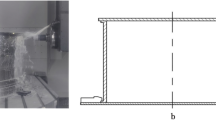Abstract
In present study, a virtual prototype of self-propelled artillery was constructed based on virtual prototype technology, and the whole impact process of artillery firing simulation was completed using ADAMS and AMEsim software. Results showed that the constructed artillery firing simulation system was reasonable. It could add a recoil dynamic response suitable for live firing to the tested artillery and could detect the vibration response characteristics of the artillery through the test device. Through numerical simulation, a quantitative analysis of artillery firing stability, stress state, and fatigue life under different working conditions was performed. All simulation results were in good agreement with the real situation. This research provides a certain reference for the evaluation of artillery firing stability and lays a good theoretical foundation for the engineering development and practical application of the test device.
Similar content being viewed by others
Abbreviations
- LVC :
-
Live firing condition
- STC :
-
Simulation test condition
- ATC :
-
Accelerated test condition
References
X. Xu, H. Tao and J. Han, Shock mechanism analysis and simulation of high-power hydraulic shock wave simulator, Shock Vib., 2017 (2017) 4361256.
Y. Yangwu, Numerical simulations of test system and dynamics of the gun recoil, Journal of China Ordnance, 22 (2) (2001) 152–155.
X. Hang and Z. Zhang, Study on dynamic simulation experiments in a artillery dynamic recoil test, Journal of Ballistic, 7 (1) (1995) 29–33.
D. Changchun, Y. Yuliang and Q. Yuliang, Research on the effect of shock parameters in a artillery dynamic recoil test device, Journal of Artillery Launch and Control (2) (2012) 25–28.
K. Xu and W.-J. Li, Simulation and analysis of the impulse characteristics of gun recoil experiment device, Machinery and Electronics (8) (2015) 49–52.
Y.-F. Gao, D. Wang, Z. Tao and Y. Liu, Design of the elastomer shock loading buffer, Chinese Hydraulics & Pneumatics (11) (2019) 136–141.
S. Jiao, Y. Wang and L. Zhang, Shock wave characteristics of a hydraulic damper for shock test machine, Mech. Syst. Signal. Pr., 24 (5) (2010) 1570–1578.
S. Duym, R. Stiens and K. Reybrouck, Evaluation of shock absorber models, Vehicle Syst Dyn, 27 (2) (1997) 109–127.
M. Shams, R. Ebrahimi and A. Raoufi, CFD-FEA analysis of hydraulic shock absorber valve behavior, Int. J. Auto Tech-Kor, 8 (5) (2007) 615–622.
J. Jiuhong, D. Jianye and H. Hongxing, Design method for fluid viscous dampers, Arch. Appl. Mech., 78 (9) (2008) 737–746.
C-Y. Hou, Fluid dynamics and behavior of nonlinear viscous fluid dampers, J. Struct. Eng., 134 (1) (2008) 56–63.
C-Y. Hou, Behavior explanation and a new model for nonlinear viscous fluid dampers with a simple annular orifice, Arch. Appl. Mech., 82 (1) (2012) 1–12.
C. Y. Hou, D. S. Hsu and Y. F. Lee, Shear - thinning effects in annular - orifice viscous fluid dampers, J. Chin. Inst. Eng., 30 (2) (2007) 275–287.
H. Deng, J. Ma and L. Haipin, Research on model building and simulation of self-propelled gun firing dynamics, Mechanical Science and Technology for Aerospace Engineering, 31 (4) (2012) 543–546.
K. Shen, Finite element dynamic analysis and fatigue life estimation of a certain artillery carriage, Dissertation, Nan**g University of Science and Technology (2008).
H. **e, H. Wang and B. Hao, Modeling and experimental validation of tracked vehicle dynamics, Agricultural Equipment and Vehicle Engineering, 56 (6) (2018) 44–48.
H. Su, Experimental technology study on high overload air cannon system, Dissertation, North University of China (2018).
J. T. P. Castro and M. A. Meggiolaro, Fatigue Design Techniques: Vol. I - High-Cycle Fatigue, CreateSpace Independent Publishing Platform (2016).
J. T. P. Castro and M. A. Meggiolaro, Fatigue Design Techniques: Vol. II - Low-Cycle and Multiaxial Fatigue, CreateSpace Independent Publishing Platform (2016).
N. E. Dowling, Mechanical Behavior of Materials: Engineering Methods for Deformation, Fracture, and Fatigue, 3rd Edition, Pearson (2006).
Acknowledgments
This work was supported by the Natural Science Foundation for Young Scientists of Shanxi Province, China (Grant No. 202203021212139).
Author information
Authors and Affiliations
Corresponding author
Additional information
Taiyang Li is a teacher of College of Mechatronics Engineering, North University of China, Taiyuan, P.R. China. He received his Ph.D. in Bei**g Institute of Technology. His research interests include weapon system design, weapon transient dynamics research and weapon low recoil technology research.
Rights and permissions
About this article
Cite this article
Guo, Z., Yuan, Z., Yang, Y. et al. Co-simulation of self-propelled artillery based on virtual prototype technology. J Mech Sci Technol 37, 6617–6627 (2023). https://doi.org/10.1007/s12206-023-1133-y
Received:
Revised:
Accepted:
Published:
Issue Date:
DOI: https://doi.org/10.1007/s12206-023-1133-y



